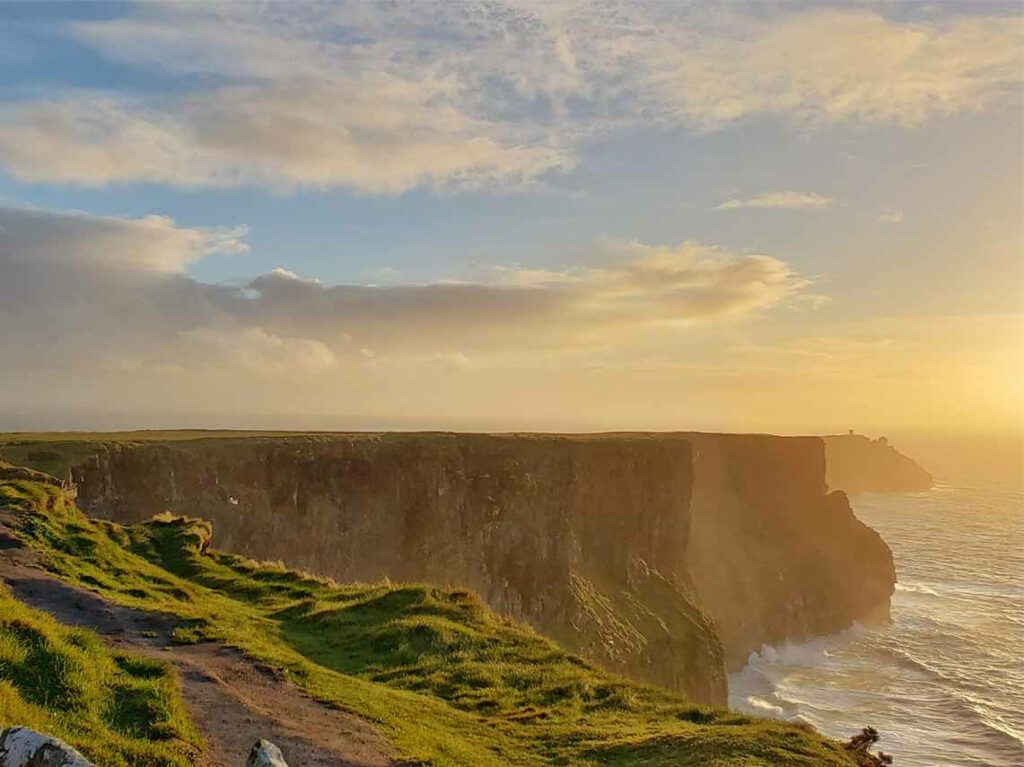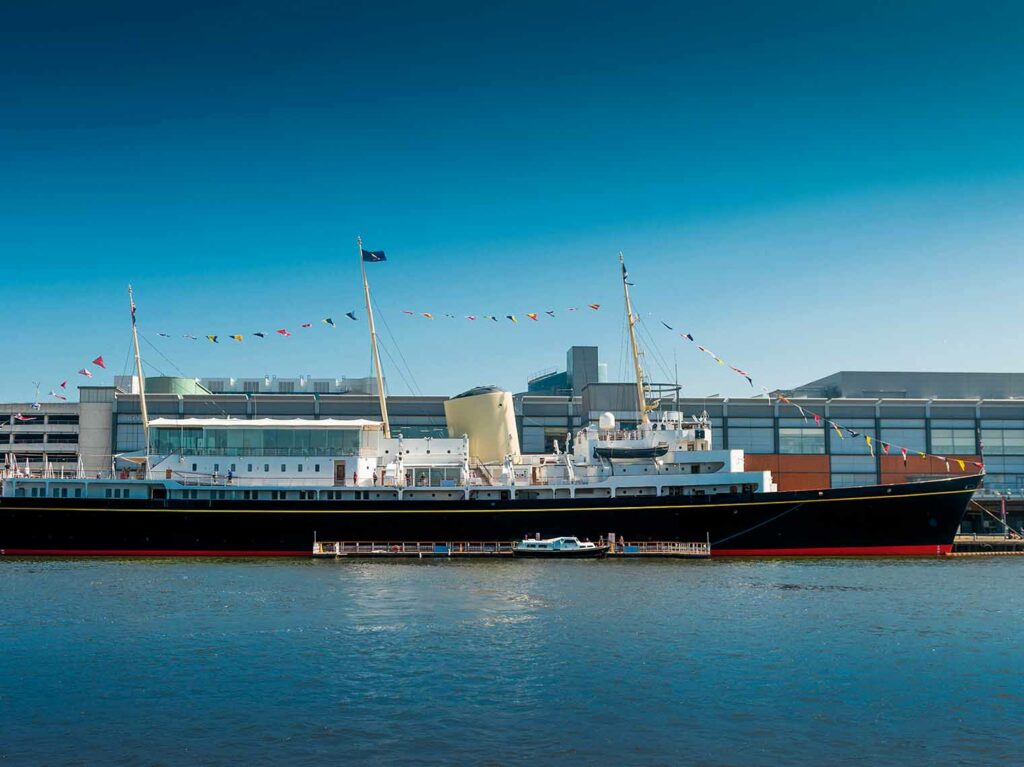16 Day Private Tour of Scotland Itinerary



Private Tours of Scotland tailored To Suit You
The itineraries we offer on our site are a template, where we hope you can find out more about what you’d like to do and see in Scotland, before getting in touch with our expert travel planners to design you a fully customized and truly unforgettable private tour!
Included
- Risk-free booking guarantee: Full refunds up to 7 days before the start date
- Certified driver-guides with 15+ years of experience, passionate about sharing their love of Scotland
- Exclusive experiences that others without our local insight will not include
- Travel in style in our luxury air-conditioned Mercedes vehicles
- Fully customizable bespoke and complimentary itinerary for your vacation
Day 1: Edinburgh Full-Day Tour
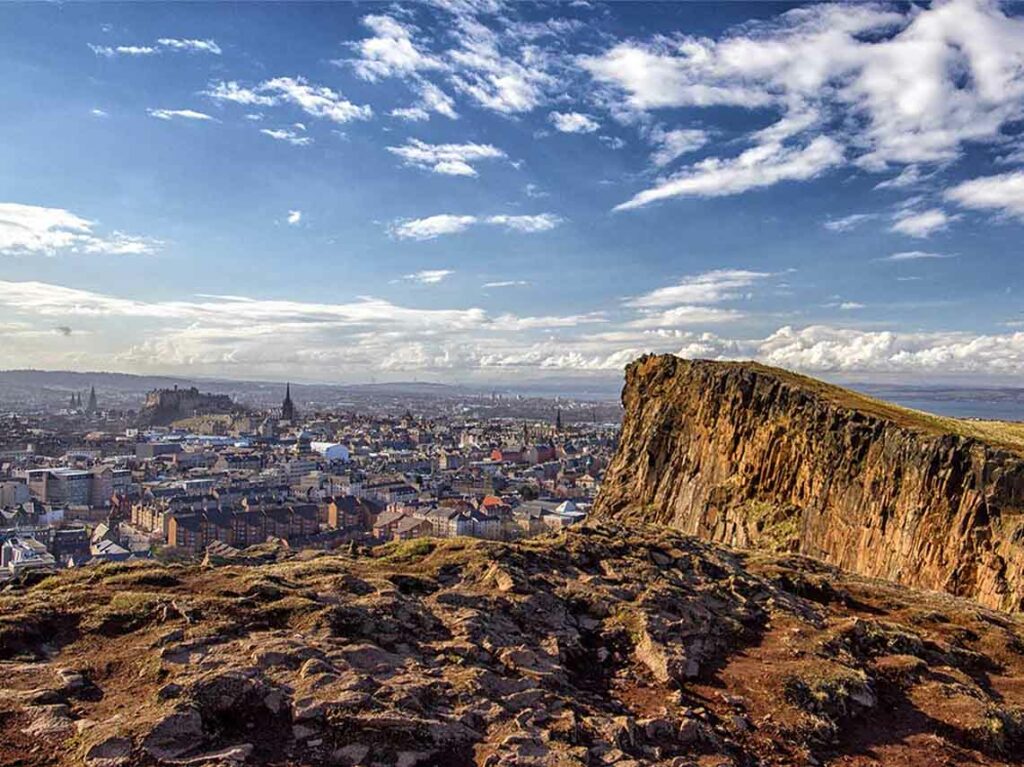
Your Braw Tour of Scotland begins as you are collected in Edinburgh, Capital of Scotland by your driver-guide.
Edinburgh lies on the East coast of Scotland, built upon a group of hills, and has a medieval old town and exquisite Georgian new town with gardens and neoclassical buildings that loom over the city.
You can choose to do 1 or 2 of the following:
Edinburgh Castle
Proudly overlooking the nation’s capital city, we will visit Edinburgh Castle, one of the oldest, attractive, and interesting fortified places in Europe. Alongside hosting the Scottish Crown Jewels and the Stone of Destiny, each section of the Castle has an exciting tale to tell, whether that’s as a Royal residence, military garrison, or more ominously, as a prison and fortress.
Palace of Holyroodhouse
Next on our Edinburgh tour, we can visit the glorious Holyrood Palace – the official residence of the British monarch in Scotland, Queen Elizabeth II.
We’ll spend an hour or so exploring the palace – including the 16th-century historic apartments of Mary, Queen of Scots – and its impressive surrounding grounds.
Royal Yacht Britannia
Continuing our Edinburgh adventure, we’ll visit perhaps one of the most famous (unsunk) ships in the world: The Royal Yacht Britannia.
This former floating palace spent 43 years traveling more than a million nautical miles around the globe in service of Her Majesty The Queen before (thankfully for us) being permanently berthed in Edinburgh – allowing the public to tour and explore this magnificent piece of engineering history.
Royal Mile
Next, we can take a stroll along the winding paths and cobbled streets of the Royal Mile the main thoroughfare of the Old Town.
Arthur's Seat
Finally, we can visit Arthur’s Seat: an extinct volcano and is the main peak of the group of hills in Edinburgh. We can drive straight over the top of this hill (or you may enjoy a short hike instead) where we shall have wonderful views of the city.
After a long day exploring many of Edinburgh’s sites, we head back to your accommodation for the evening.
Day 2: Edinburgh Outskirts Day Trip

Today we shall venture out of Edinburgh and explore some of the surrounding sights, starting with:
Melrose Abbey
First, we will visit the Melrose Abbey, a magnificent ruin on a grand scale with lavishly decorated masonry. Probably the most famous ruin in Scotland, the abbey was founded by David I in 1136 for the Cistercian Order, and it was largely destroyed by Richard II’s English army in 1385. The surviving remains of the church are of the early 15th century and are of an elegance unsurpassed in Scotland.
Objects found during excavation are displayed in the Commendator’s House. The exterior of this magnificent ruin is decorated with unusual sculptures, including hobgoblins, cooks with ladles, and a bagpipe playing pig.
Traquair House
Moving on we will visit the oldest inhabited house in Scotland and discover its fascinating history. Once a pleasure ground for Scottish kings in times of peace, then a refuge for Catholic priests in times of terror, the Stuarts of Traquair supported Mary Queen of Scots and the Jacobite cause without counting the cost.
Imprisoned, fined, and isolated for their beliefs, their home, untouched by time, reflects the tranquillity of their family life. Traquair was the most prominent Jacobite house in Southern Scotland. The Stuarts of Traquair maintained their loyalty to the cause from the earliest day to after ’45.
Rosslyn Chapel
Next on your tour today, we’ll pay a visit to Rosslyn Chapel: a 15th-century structure situated on the outskirts of the city in the village of Roslin.
This marvelous building was also used in the making of the epic thriller ‘The Da Vinci Code’.
You will once again retire for the evening at your accommodation in Edinburgh.
Day 3: St Andrews Day Trip From Edinburgh

Today we’ll leave Scotland’s beautiful capital city behind as we head for a tour of St Andrews, passing through some charming fishing villages along the way.
The Queensferry Crossing
As we depart the city we’ll cross over the newly built Queensferry Crossing where we will see 3 magnificent bridges which span the river Forth. Each of these bridges was built in a different century!
Pittenweem
Our first stop is Pittenweem: a fishing village that oozes charm. The harbor is a magnet for visitors. Photographers can take their pick between the brightly hulled fishing boats, or the jumble of red pantiled or grey slatted houses.
Anstruther
Next, we will pass through Anstruther, a busy, seaside village which is most famous for its award-winning fish and chips which taste even better eaten in the fresh air overlooking the lovely harbor.
St Andrews
We will then stop in and explore St Andrews, a charming and historic town that attracts visitors from all over the world. St Andrews is known worldwide as The Home of Golf, and also boasts Scotland’s oldest university.
St Andrews University, founded in 1410, dominates the center of town. The elegant, ivy-clad buildings and delightful quadrangles and gardens have seen a procession of famous graduates such as Prince William. One of the top universities in Britain, St Andrews is often compared to Oxford and Cambridge for its defining presence and the collegiate feel it gives to the town.
The Medieval center of St Andrews consists of a series of narrow alleys and cobbled streets with shops, restaurants, and cafés. Explore the castle, the now ruined cathedral, and the adjacent church of St Regulus, where you can climb the spiral staircase to the top of the 108 ft tower for magnificent views of the town and its surroundings.
Finally, we’ll head back down the coast to return you to your accommodation in Edinburgh in the evening.
Day 4: Falkirk & Stirling Tours
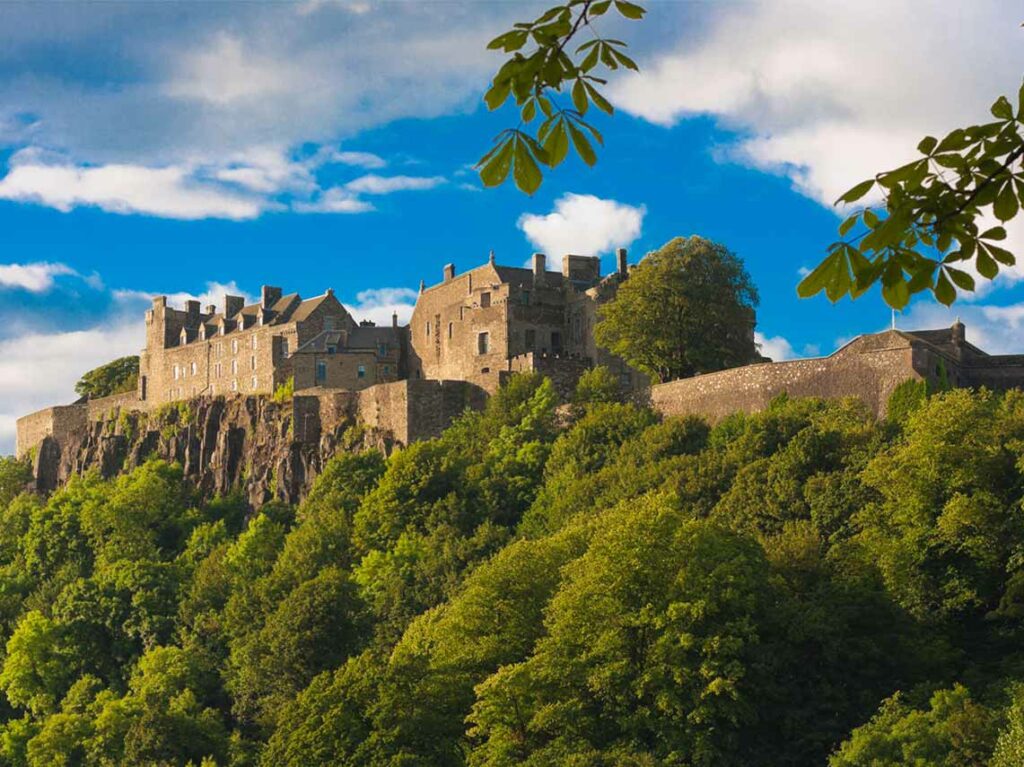
Today we’ll leave the national capital as we head along the M9, first stopping at the wonderful Kelpies for some photographs:
The Kelpies
The Kelpies are the largest equine sculptures in the world standing at 30-meter-high horse head sculptures which are a true feat of engineering.
Falkirk Wheel Visitor Centre
Moving on we will visit the Falkirk Wheel is the world’s first and only rotating boat lift, designed and built to connect the Forth & Clyde Canal and the Union Canal which allows coast to coast navigation across central Scotland.
The magnificent structure stands 115ft tall and requires only the power of eight domestic kettles to sailboats through the air and transfer them between the two canals. The Falkirk Wheel has not only been described as a feat of engineering but as a work of art and is now an iconic Scottish landmark attracting over 500,000 visitors a year.
Stirling Castle
Next on your tour, we’ll head to Stirling Castle: one of Scotland’s most historically important sites which was once a favored residence of the Stewart kings and queens who held grand celebrations at the castle.
In its grandeur with its superb sculptures and beautiful gardens. You can meet the costumed characters in the roles of bodyguards, court officials, maids of honor, and servants who will welcome you into 16th-century life. If you want you can also dress in a period costume and play medieval instruments.
You can also have a guided tour with knowledgeable staff who will bring the castle’s infamous characters and history to life in great detail. Other highlights include the Great Hall, Chapel Royal, Castle Exhibition, Regimental Museum, Great Kitchens, Tapestry Studio, and the nearby Argyll’s Lodging, a 17th-century townhouse.
National Wallace Monument
Above the fields where the famous martyr led his Scottish troops to victory against the English forces at The Battle of Stirling Bridge stands the William Wallace Monument built-in 1869.
While many will be familiar with Wallace’s exploits from the Hollywood movie, “Braveheart”, inside the monument you can find out all about Wallace’s real-life tales intertwined, of course, with the story of the struggle for Scottish Independence.
You will also be able to examine the Wallace sword said to have been used by the man himself in battle. If you make it all the way up the 246 steps of the spiral stairs to the top of the Monument, you will be rewarded with fantastic views over Stirling.
Dunkeld Cathedral
Next on our tour is the beautiful Dunkeld Cathedral.
Dunkeld Cathedral stands on the north bank of the River Tay in Dunkeld, Perth, and Kinross, Scotland.
It is approached on foot through the narrow streets which lead you to the Cathedral’s ornate gates. With the river on one side and open land leading to hills on the other, the setting is idyllic. The site has been holy ground since about 730AD when Celtic missionaries built the first monastery here. The major development came in 848AD, when Kenneth MacAlpin, by then King of the Scots and of the Picts, rebuilt the original wattle buildings in red stone. Two years later Dunkeld became the religious center of Scotland when the relics of St Columba were moved here from Iona in the face of increasing Viking attacks on the west coast.
Finally, after you’ve had some time to explore Dunkeld town and it’s beautiful cathedral, we’ll continue north to our accommodation for the evening: the stunning Victorian town of Pitlochry.
Day 5: Private Day Tour from Pitlochry

Today we will venture out and explore some of the sights surrounding Pitlochry.
Highland Mountain Safaris
Firstly, you will have a Highland Safari in Aberfeldy. Armed with cameras and binoculars, climb aboard your Land Rover or Pinzgauer and journey to the high tops through a land sculptured by the elements and steeped in history, culture, nature, and breath-taking views with no shortage of photo opportunities. You may even be lucky enough to see the Majestic Red Deer, the Famous Grouse, the elusive Mountain Hare, or the soaring Golden Eagle as you travel through forests, mountains, and moors on private hill tracks.
Queen's View
Next, we will visit The Queen’s View in Highland Perthshire which overlooks Loch Tummel and is said to have been named after Queen Victoria, following her visit to the area in 1866. The Queen’s View Visitor Centre lies at the eastern edge of Loch Tummel and is surrounded by part of Tay Forest Park. As well as a stunning viewpoint overlooking the loch and beyond the iconic Schiehallion, the area offers a range of woodland walks suitable for all abilities.
The House of Bruar
We can stop for some shopping at The House of Bruar, Scotland’s answer to Harrods which is widely acknowledged as Scotland’s most prestigious independent store, and its regal stature at the gateway to the Highlands makes it clear to see why. The store offers an extensive range of high-quality products in both the Men’s and Ladies clothing halls.
There is also a taste of luxury from gourmet produce, artisan treats, and a fine selection of whisky and spirits in the Food Hall – which also houses the award-winning in-store butchery and delicatessen. Housing the largest collection of Cashmere in the UK, you will be spoilt for choice in the Knitwear hall – which carries a large variety of high-quality natural fibers. The use of natural fibers extends further into their ample offerings of Tweed garments and accessories, reflecting the Scottish heritage within the brand.
Edradour Distillery
Now we shall take a tour of Edradour Whisky Distillery.
Edradour is perhaps best known as one of Scotland’s smallest distilleries, producing a mere 90,000 liters per annum with a workforce of just three. Established in 1825 in the hills of Pitlochry, Edradour (pronounced ‘EDD-ra-DOWer’) maintains its heritage as an almost artisanal distillery. The heart of the range, a ten-year-old, exhibits an unconventional charm, uncharacteristic of a highland single malt.
And once you’ve had your fill of Scottish spirit, we’ll head to your accommodation in Pitlochry for the evening.
Day 6: Pitlochry to Inverness Tour

Today we will head through the Cairngorms National Park on our way to Inverness, stopping at some attractions along the way.
Cairngorms National Park Drive
On our route to our first stop, we will enjoy a scenic drive through Cairngorms National Park – the largest national park in the entire UK.
Five of the UK’s six highest mountains lie inside Cairngorms National Park. There are huge forests there, cascading waterfalls, and rich wildlife. The Cairngorm Mountains are the most popular ski resort in the UK and the park also offers many exciting hiking routes. It also offers many great mountain-bike and cross-country skiing trails – if you’d like us to arrange extra outdoor activities during this part of the tour, please let us know and we’ll include some options for you.
Ruthven Barracks
Today will start with a visit to Ruthven Barracks, a picturesque infantry barracks built in 1719 as a reaction to the first Jacobite rising of 1715. The barracks sits atop a large rocky mound, which was formerly occupied by a 13th-century castle once occupied by the notorious ‘Wolf of Badenoch’, Alexander, 1st Earl of Buchan. Ruthven Barracks was literally the Jacobites last stand after the battle of Culloden. Nearly 3000 men from the battle gathered at Ruthven to await further instructions from the Prince, only to be told days later that the cause was lost and they were to look after themselves.
Loch Ness Cruise
We will visit the legendary Loch Ness. This beautiful loch located near Inverness is shrouded in mystery. Tales of a large monster living deep beneath the dark expanses of Loch Ness have circulated the world since the first photograph emerged in 1933. With over 1,000 eye-witness accounts, sightings, and unexplained evidence, scientists continue to be baffled by the existence of Nessie, the Loch Ness Monster!
We will have a cruise on the Loch and view the castle on a one-hour voyage across the deepest, mysterious waters of Loch Ness. From here, treat those peepers – and your camera – to the breathtaking sight of the historic Urquhart Castle.
The onboard audio is bursting with lots of facts and legends to tune into as you sail. And don’t forget to look out for Nessie, with a little help from the onboard sonar.
Urquhart Castle
The ruins of Urquhart Castle are located on a small promontory, overlooking Loch Ness. The ruins date from the 13th to the 16th centuries, and are built on the site of an early medieval fortification. The castle is one of the largest in Scotland in area, and one of the most visited castles in Scotland. Loch Ness is of course the home of Nessie, the monster supposedly living in the lake and, in fact, many Nessie sightings have been reported from where the castle stands.
Once you’ve explored Loch Ness and Urquhart Castle with your guide, we’ll finish the day with a short drive to Inverness, the Capital of the Highlands.
Day 7: Inverness & Surrounding Areas Tour

Today will be spent exploring the surrounding areas of Inverness.
Clava Cairns
We will begin with a visit to the Clava Cairns or the Prehistoric Burial Cairns of Bulnuaran of Clava is a group of three Bronze Age cairns located near Inverness. A hugely significant and exceptionally well-preserved prehistoric site, Clava Cairns is a fantastic example of the distant history of Highland Scotland, dating back about 4,000 years.
The cemetery was used in two periods. At around 2000 BC a row of large cairns was built, three of which can still be seen today. A thousand years later the cemetery was reused, and new burials were placed in some of the existing cairns and three smaller monuments were built including a ‘kerb cairn’. Traces of a smaller cemetery can also be seen at Milton of Clava, a short distance up the valley to the west. The cairns at Balnuaran of Clava extended along a gravel terrace raised above the River Nairn.
Culloden Battlefield
Next, we will visit the Culloden Battlefield. On 16 April 1746, the final Jacobite Rising came to a brutal head. Jacobite supporters, seeking to restore the Stuart monarchy to the British thrones, gathered to fight the Duke of Cumberland’s government troops. It was the last pitched battle on British soil and, in less than an hour, around 1,500 men were slain – more than 1,000 of them Jacobites.
The richly researched, stimulating, and sensitive Culloden Visitor Centre, which stands beside the battlefield, features artifacts from both sides of the battle and interactive displays that reveal the background to the conflict. It stands as a monument and a guide to a pivotal day in history.
Discover how a bloody fight that lasted only an hour changed life in the Highlands forever.
Cawdor Castle
Our final stop today will be to Cawdor Castle, a romantic Highland castle and the 14th century home of the Thanes of Cawdor. Located about 5 miles southwest of Nairn, Cawdor Castle was built around a 15th-century tower house that originally belonged to Clan Cawdor before passing into the hands of Campbells in the 16th century. Although famed for its literary connection to Shakespeare’s Macbeth, the actual 11th-century events upon which the play is based took place many years before the castle was built.
However, the castle does boast its own unique tale surrounding its construction: According to legend, the castle is built around a thorn tree, which has since been identified as a holly dating from 1372, which visitors can still see today in the dungeon.
We will again retire at your accommodation in Inverness.
Day 8: Inverness To Ullapool Day Tour

This morning we will start by visiting some of the Highlands’ stunning attractions before ending the day in the town of Ullapool.
Rogie Falls
First up we have Rogie Falls: a series of lovely walks on the Black Water which you can follow to see the waterfall that is famous for salmon viewing. This beautiful spot is situated off the main road to Ullapool just over a mile northwest of the village of Contin. It offers several good forest walks.
There is plenty of waymarked walks and seating at a viewpoint overlooking the falls.
Inverewe Garden
Now time to visit Inverewe Garden: Amazing species that simply shouldn’t grow here are thriving, aided by the effects of the Gulf Stream. From prehistoric trees such as our Wollemi pines to rhododendrons from China, Nepal, and India, Himalayan poppies, and Tasmanian eucalyptus, there is something to discover and enjoy in every corner.
The estate has many designations recognizing its importance as a species-rich habitat. The wildlife hide provides the perfect vantage point over Loch Ewe, where coastal birds, seals, and otters can be seen.
Corrieshalloch Gorge
Wester Ross is home to our next destination on this action-packed day, the Corrieshalloch Gorge. Corrieshalloch is a slot gorge or box canyon, that was cut as far back as 2.6 million years ago by Ice Age glacial meltwater. The River Droma forges through the gorge, dramatically dropping 100 meters in just 1.25 km through a series of waterfalls, including the thunderous 45m high Falls of Measach.
Ullapool
Finally, we will visit the picturesque fishing town of Ullapool, nestled on the shores of Lochbroom. Described as an outdoor paradise with a ‘Scandinavian twinkle in winter and Canadian-style adrenaline in summer’ and voted one of the UK’s top 10 outdoor destinations by Outdoor Fitness magazine, the town guarantees a truly unforgettable experience.
We will then retire for the evening in Ullapool ahead of your ferry journey to the Isle of Harris & Lewis.
Day 9: Private Tour From Ullapool to Isle of Harris & Lewis

We will this morning board the ferry onto the Isle of Harris & Lewis which takes approximately 2 hours 30 minutes.
Stornoway
Once back on dry land we will have arrived at Stornoway – the Island’s ancient capital.
Initially founded by Vikings in the early 9th-century with the Old Norse name Stjórnavágr, today the town boasts a population of 8,000 – making it the largest town in the Hebrides, with a third of the population of the civil parish of Stornoway, which includes various nearby villages and has a population of approximately 12,000. Stornoway is an important port and the major town and administrative center of the Outer Hebrides. It is home to Comhairle nan Eilean Siar and a variety of educational, sporting, and media establishments. Observance of the Christian Sabbath has long been an aspect of the island’s culture. Recent changes mean that Sunday on Lewis is now less different from Sunday on the other Western Isles or the mainland of Scotland.
Butt of Lewis Lighthouse
We will then visit The Butt of Lewis, the most northerly point of Lewis in the Outer Hebrides. The headland, which lies in the North Atlantic, is frequently battered by heavy swells and storms and is marked by the Butt of Lewis Lighthouse. The nearest populated area is the village of Eoropie, about 1 mile (1.6 km) to the south. In 2012 There was a festival called Goater and it was one of the most successful festivals of the century on the isle.
We will then spend the evening on the Isle of Harris & Lewis.
Day 10: Harris & Lewis Full Day Tour

Today we will explore much of the Isle of Harris & Lewis and its many fantastic attractions.
Great Bernera, Loch Roag & Iron Age House
First, we will take a picturesque drive to the island Great Bernera which lies in Loch Roag on the north-west coast of Lewis – linked by the first prestressed concrete road bridge in Europe, built back in 1953. Once on the island, we will visit Bostadh – a replica Iron Age house that was only discovered after the great storm of 1993.
Dun Carloway Broch
Next, we shall visit a broch, these two-thousand-year-old stone structures date from the Iron Age, and it is estimated that at least seven hundred brochs once existed across Scotland.
Callanish Standing Stones
We will then visit the 5000-year-old Callanish Stones on the west coast of Lewis – which still stand today at almost 5-meters high.
In Scots folklore, it is said that the Callanish Stones were petrified giants who would not convert to Christianity and thus, turned into stone. While other myths tell of how early on a midsummer morning, an entity known as the “Shining One” walks the length of the avenue with his coming heralded by the call of the local cuckoo birds.
The Callanish Stones rose to fame outside of the UK after the Starz TV series Outlander (2014) used them to depict the fictional time-traveling stone circle near Culloden called Craigh na Dun (unfortunately we cannot promise with 100% certainty that the stones do not indeed have time-traveling abilities, so please only touch the stones at your own risk).
After all your exploring it is back to your hotel to spend your second evening on the Isle of Harris & Lewis.
Day 11: Private Tour From Harris & Lewis To The Isle of Skye
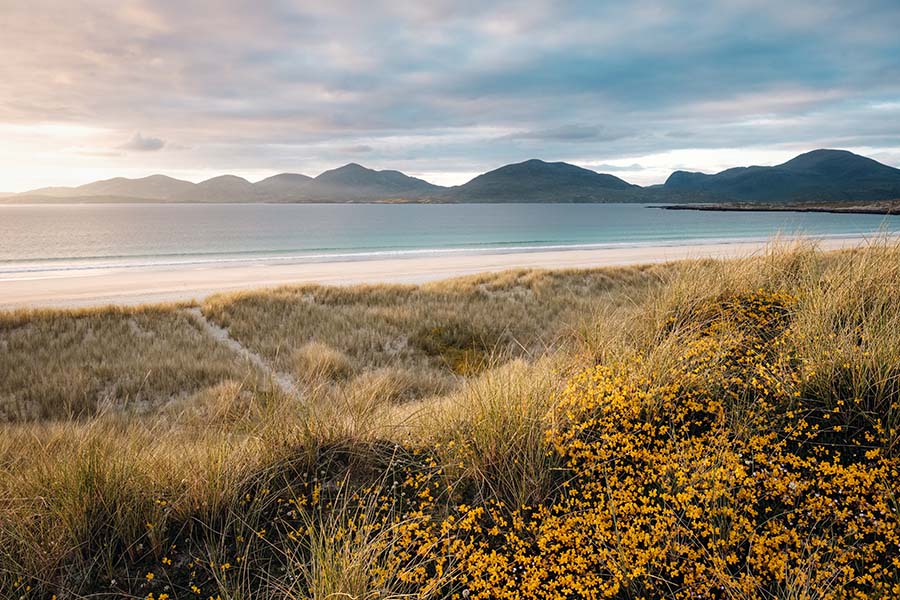
Your final day on the Isle of Harris & Lewis starts with a visit to the beautiful St Clement’s Church.
St Clements Church
St Clement’s Church (sometimes known as Eaglais Roghadail or Rodel Church) was built back in the late fifteenth century for the Chiefs of the MacLeod’s of Harris and dedicated to Pope Clement I.
Luskentyre Beach
Now we will take a leisurely stroll along Luskentyre Sands: a string of beautiful white beaches that ripple down to stunningly bright turquoise waters – a little slice of heaven where you can forget the rest of the world.
Tarbert - Isle of Skye Ferry
Now it is off to Tarbert – located on Harris, the southern and more mountainous region of Lewis & Harris and board the ferry to the magical Isle of Skye – arriving at the small town of Uig.
On arrival, we will head straight to our hotel on the Isle of Skye, where we will spend the evening.
Day 12: Full-Day Guided Tour of Skye (1/2)

Today your driver-guide will collect your group from your accommodation and take you on a tour of some of Skye’s premier tourist sites, starting with the delightful town of Portree.
Portree
Set round its natural harbor and fringed by high ground and cliffs, the town is a popular tourists’ holiday destination and the harbor continues to be used by fishing boats as well as pleasure craft. It boasts excellent leisure facilities including a swimming pool, pony-trekking, and boat cruises plus plenty of shopping opportunities making it the ideal place for a pause for a spot of lunch or to just sit back and enjoy the views.
The Storr
The Old Man of Storr is situated in the north of the Isle of Skye in the Trotternish area. Famous for its magnificent scenery and views, the Old Man of Storr is a popular hotspot for hikers, hill walkers, and photographers. You can take the opportunity to walk up and down the Storr on a 3.8km route that takes 1 hour and 15 minutes to complete.
Kilt Rock & Mealt Falls Viewpoint
Even the landscapes of Scotland follow traditional fashion. Indeed, the 90-meter Kilt Rock, our next destination on the Trotternish Peninsula does look strikingly similar to a pleated kilt. Composed of sea-weathered basalt columns, the colors of the rocks might even appear to be tartan. And just as a man with a kilt might blow the bagpipes, this landscape makes some unusual music of its own; when strong winds blow many visitors have reported a haunting, beautiful sound. One might think there’s fairy folklore behind it, but it’s just the noise from the fence surrounding the lookout point.
From the cliff-top viewpoint, you can also get a nice look at Mealt Falls, a waterfall that plummets 328 feet (100 m) over Kilt Rock to the rock-laden shoreline below.
Dunvegan Castle & Gardens
Any visit to the Isle of Skye is incomplete without enjoying the wealth of history and clan legend on offer at Dunvegan Castle & Gardens, the ancestral home of the Clan MacLeod. Sir Reginald MacLeod (27th Chief) was the first Chief to open Dunvegan to the public in 1933 for charitable purposes two days a week. Since then, the number of visitors has risen from a few hundred to hundreds of thousands.
Neist Point
Moving on we will visit one of the most photographed points on Skye, Neist Point, you will not be disappointed with the sheer cliffs & birdlife a plenty. The fast-running tide on Neist Point also makes it an ideal place to spot Basking Sharks and Minke Whales feeding in the tidal stream.
Finally, we shall spend the evening on the Isle of Skye.
Day 13: Full-Day Guided Tour of Skye (2/2)

We’ll begin your second day tour on the Isle of Skye as your driver-guide picks your group up from your accommodation and heads to:
The Fairy Pools
Fairy Pools are located in the southwest part of the Isle of Skye, off the west coast of Scotland.
The Fairy Pools are almost hypnotic, beautifully crystal-clear blue pools on the River Brittle. These famous pools attract visitors from all over the world. Most visitors complete the walk up to the pools to enjoy the magnificent view and for the fact that these magical Fairy Pools make for fantastic photos. Others, the more adventurous visitors, go there for some wild swimming in the blue, cold water.
The hike to the Fairy Pools is considered a fairly easy one, and most visitors take their time working their way up the river and exploring the other waterfalls and pools to be found on the way to the Fairy Pools.
Elgol
We can then take a very scenic drive along a single-track road towards the village of Elgol, where we will get amazing views over to the Cuillin Mountains.
Loch Coruisk Boat Trip
Next, we’ll take a small boat trip to Loch Coruisk in the heart of the Cuillin Mountains, often joined en route by a colony of local seals!
After your boat trip, we’ll head back to your accommodation for the evening on the Isle of Skye.
Day 14: Tour From Isle of Skye to Oban

Today we shall board a ferry back to the mainland before a drive along the scenic route to the Isles – stopping at some incredible destinations along the way – before finishing the day in the town of Oban.
We’ll arrive at the beautiful coastal town of Mallaig to explore its harbor after catching the ferry from the Isle of Skye.
Morar
On the road to the isles we will start by visiting Morar, a small village on the west coast of Scotland, 3 miles (5 km) south of Mallaig. The name Morar is also applied to the wider district around the village.
Morar has a railway station on the West Highland Line and is on the A830, part of the Road to the Isles, between Fort William and Mallaig. It is famous for Morar Beach, known as the “White Sands of Morar”, which featured prominently in the film Local Hero, as well as in Breaking the Waves. Loch Morar, the deepest freshwater body in the British Isles, is nearby, as well as the short River Morar which flows from the loch to the sea.
Morar was a favorite winter travel destination of the noted English composer, Sir Arnold Bax (1883–1953), during the 1930s. He worked on his Third Symphony and each subsequent symphony during his visits to the Station Hotel there.
Loch Morar
Loch Morar is a freshwater loch in Lochaber, Highland, Scotland. It is the fifth-largest loch by surface area in Scotland, at 26.7 km2 (10.3 sq mi), and the deepest freshwater body in the British Isles with a maximum depth of 310 m (1,017 ft). The loch was created by glacial action around 10,000 years ago and has a surface elevation of 9 meters (30 ft) above sea level.
Glenfinnan Viaduct
Next, it’s onto Glenfinnan Viaduct, where we can stop for some pictures.
The famous Glenfinnan viaduct carries the railway to Glenfinnan Station across a 1,000 ft span, 100 ft above the ground. The Jacobite steam train runs from here to Fort William and Mallaig in the summer months.
The filming of the second and third Harry Potter books, Harry Potter and the Chambers of Secrets and Harry Potter and the Prisoner of Azkaban took place in this area with the Hogwarts Express calling at Glenfinnan!
Neptune's Staircase
Moving on we will visit Neptune’s Staircase. This amazing feat of engineering raises the canal by 19m (62ft) over a quarter of a mile of continuous masonry and takes around 90 minutes for a boat to travel up or down the locks.
Built by Thomas Telford between 1803 and 1822, it is the longest staircase lock in Scotland. An ideal location for enjoying ‘gongoozling’ the boats as they travel up and down the lock flight!
Glencoe
Next, we shall visit the magnificent Glencoe Mountains.
The areas around Glencoe have hikes suitable for a wide range of activity levels so don’t worry if you don’t want to climb up to the top – we’ll still manage to get to some incredible viewpoints, particularly of the ‘Three Sisters’ scenic area.
Castle Stalker
As we head down the coastline keep an eye out for Castle Stalker, a four-story tower house, or keep picturesquely set on a tidal islet on Loch Laich, an inlet off Loch Linnhe. It is about 1.5 miles (2.4 km) northeast of Port Appin, Argyll, Scotland, and is visible from the A828 road about midway between Oban and Glen Coe. The islet is accessible (with difficulty) from the shore at low tide. The name “Stalker” comes from the Gaelic Stalcaire, meaning “hunter” or “falconer”.
In recent times, the castle was brought to fame by the Monty Python team, appearing in their film Monty Python and the Holy Grail.
McCaig's Tower
Once we arrive in Oban we will visit the McCaig’s Tower, a prominent tower on Battery Hill overlooking the town of Oban in Argyll, Scotland. It is built of Bonawe granite taken from the quarries across Airds Bay, on Loch Etive, from Muckairn, with a circumference of about 200 meters with two-tiers of 94 lancet arches (44 on the bottom and 50 on top).
The structure was commissioned, at a cost of £5,000 sterling, by the wealthy, philanthropic banker, John Stuart McCaig.
John Stuart McCaig was his own architect. The tower was erected between 1897 and his death, aged 78 from cardiac arrest, on 29 June 1902 at John Square House, Oban, Argyll.
Finally, we will retire for the evening in Oban.
Day 15: Private Tour from Oban To Glasgow

This morning your driver-guide will collect you from your accommodation and head towards Glasgow, stopping at some attractions along the way:
Kilmartin Glen
Our first stop is Kilmartin Glen, an area in Argyll not far from Kintyre, which has one of the most important concentrations of Neolithic and Bronze Age remains in Scotland. The glen is located between Oban and Lochgilphead, surrounding the village of Kilmartin.
There are more than 350 ancient monuments within a six mile radius of the village, with 150 of them being prehistoric. Monuments include standing stones, a henge monument, numerous cists, and a “linear cemetery” comprising five burial cairns. Several of these, as well as many natural rocks, are decorated with cup and ring marks.
The remains of the fortress of the Scots at Dunadd, a royal center of Dal Riata, are located to the south of the glen, on the edge of the Moine Mhòr or Great Moss. The Kilmartin House Museum of Ancient Culture is located within the village itself and aims to interpret the rich history of the glen.
Dunadd Fort
Dunadd Fort rises proudly from Moine Mhor – the ‘great moss’ – an expanse of bog that carpets the southern end of Kilmartin Glen. It was home to a fort 2,000 years ago, and a royal power center of Gaelic kings in the 500s to 800s AD. Below the mighty fort site are some extraordinary features carved into the rock, including two human footprint shapes – similar to a pair found at Clickimin Broch.
Inveraray Castle
We continue your tour with a visit to Inveraray Castle: a country house near Inveraray in the county of Argyll, in western Scotland, on the shore of Loch Fyne, Scotland’s longest sea loch. It has been the seat of the Duke of Argyll, chief of Clan Campbell, since the 17th century.
Loch Lomond
Next, it’s onto the bonnie banks of Loch Lomond:
Formed between 10,000 – 20,000 years ago during the period of the last ice age, the enchantingly beautiful Loch Lomond which we will pass is the largest freshwater lake in the UK. The loch contains many islands, including Inchmurrin, the largest fresh-water island in the British Isles. It’s a natural gateway separating the lowlands and the rugged mountainous landscape of the Scottish Highlands and a must-visit destination popular for walkers, wildlife enthusiasts, adventure seekers and tourists.
Luss
We’ll stop in the beautiful and picturesque village of Luss which lies on the banks of the loch, to explore the tour and get up close to the famed loch itself.
After a long day of touring, we will arrive at Glasgow, Scotland’s largest city and cultural hub where we will spend the evening.
Day 16: Full Day Guided Tour of Glasgow
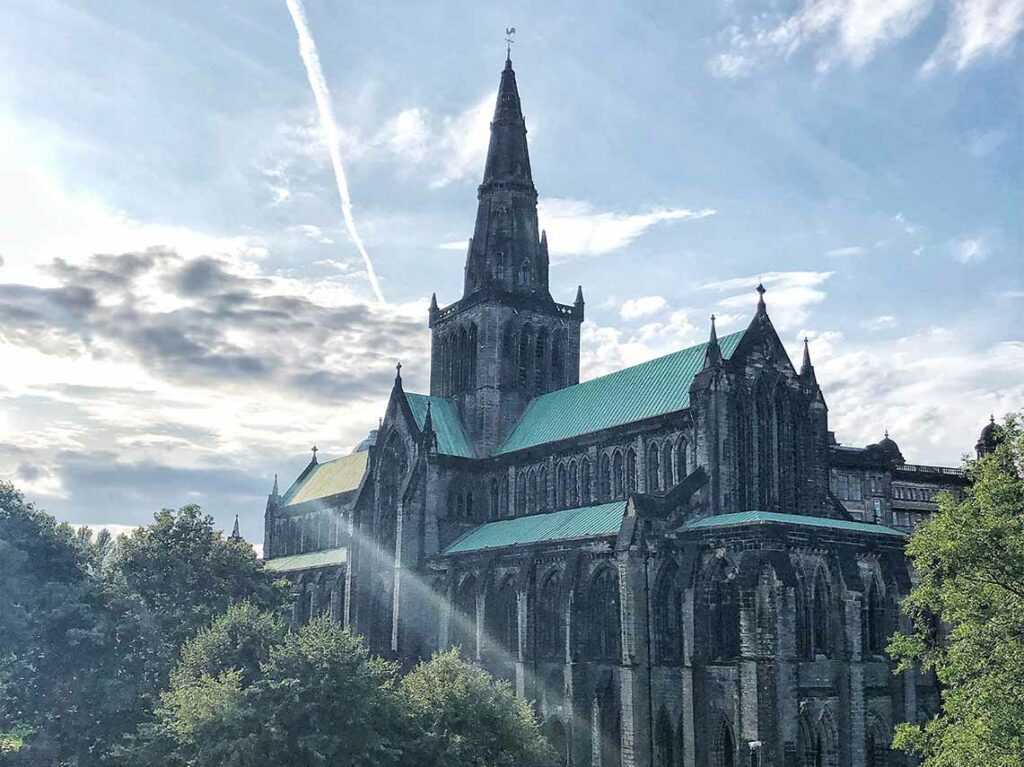
As Scotland’s largest city, Glasgow is famed for its culture, shopping and people. We will spend the day exploring a wide range of fascinating free museums and galleries, we shall also visit Glasgow University, which dates back to 1451 and the Glasgow Cathedral, one of the finest medieval churches in the UK which first opened in the 12th century.
Glasgow Cathedral
We will visit the Glasgow Cathedral, also called the High Kirk of Glasgow or St Kentigern’s or St Mungo’s Cathedral, is today a gathering of the Church of Scotland in Glasgow.
The title cathedral is honorific and historic, dating from the period before the Scottish Reformation and its former status as the Roman Catholic mother church of the Archdiocese of Glasgow and the cathedra of the Archbishop of Glasgow (which is now in St. Andrew’s Cathedral, the present mother church of the Roman Catholic Archdiocese of Glasgow). The current congregation is part of the Church of Scotland’s Presbytery of Glasgow. Glasgow Cathedral is located north of High Street and east of Cathedral Street, beside the Glasgow Royal Infirmary.
Glasgow Necropolis
Close by is The Necropolis, a Victorian garden cemetery full of wonderful architecture, sculpture, and fascinating stories.
Adjacent to Glasgow Cathedral, the Necropolis was modeled on Père-Lachaise in Paris. It is estimated that something in the order of 50,000 burials has taken place here, with around 3,500 tombs.
Built in the Classical Revival architectural fashion, the Necropolis was established by the Merchants’ House of Glasgow in 1831. A monument to John Knox, which was erected in 1825, dominates the hill.
Riverside Museum
Moving on we will visit the Riverside Museum which is Glasgow’s award-winning transport museum. With over 3,000 objects on display, there’s everything from skateboards to locomotives, paintings to prams and cars to a Stormtrooper.
There are over 90 large touch screens panels full of images, memories, and films that tell the fascinating stories behind the objects. A visit to the Riverside provides the ultimate day out. The Riverside is a multi-award-winning museum located on the banks of the River Clyde, with over 3000 objects on display from Glasgow’s rich past. You will find an incredible array of objects from skateboards and vintage cars to prams and powerful locomotives. You can even walk down an old cobbled Glasgow street with shops dating from 1895 to the 1980s.
University of Glasgow
Founded in 1451, the University is the fourth oldest in the English-speaking world and is one of Scotland’s four ancient universities. On your tour, you’ll be walking in the footsteps of some of the world’s most renowned visionaries, like economist and author of the foundational ”Wealth of Nations “Adam Smith, the pioneer of television John Logie Baird, and engineer James Watt amongst many more. Architecturally the main building is the second-largest example of Gothic revival architecture in Britain, after the Palace of Westminster, while the University Library includes “The Mackintosh House”, a rebuilt terraced house designed by, and furnished after, architect Charles Rennie Mackintosh.
Kelvingrove Art Gallery & Museum
The Kelvingrove Art Gallery and Museum is a museum and art gallery in Glasgow, Scotland. Since its 2003–06 refurbishment, the museum has been the most popular free-to-enter visitor attraction in Scotland, and the most visited museum in the United Kingdom outside London.
The gallery is located on Argyle Street, in the West End of the city, on the banks of the River Kelvin (opposite the architecturally similar Kelvin Hall, which was built in matching style in the 1920s, after the previous hall had been destroyed by fire). It is adjacent to Kelvingrove Park and is situated near the main campus of the University of Glasgow on Gilmorehill.
After a day exploring the city you will retire for the evening at your accommodation where alas, all good things must come to an end as we say our goodbyes until the next adventure.
Call +44 141 674 9535
Free for US, Canada & UK
Get A Custom Driver Guided 16 Day Tour Itinerary
All our tours are completely customizable and tailor-made to suit you and your group’s needs, just fill in the form below and tell us what you want to do and how long you’ll be visiting us and our tour experts will do the rest.
Even if you don’t know where you want to start and would like some inspiration, fill in your contact details below, and your personal tour expert will be in touch to help you plan your perfect vacation in Scotland.
Or Call Free +44 141 674 9535
Free for US, Canadian & UK numbers












